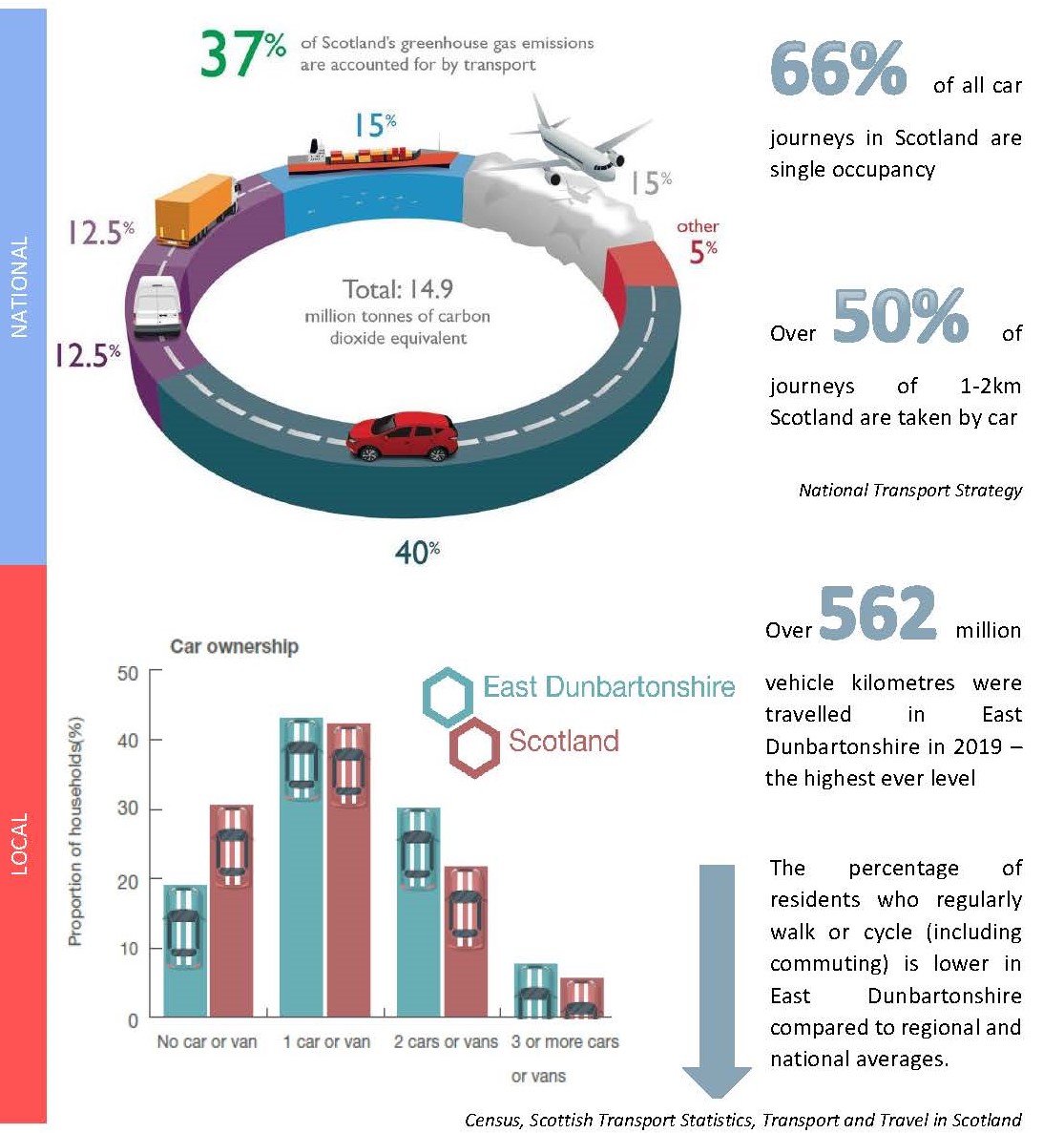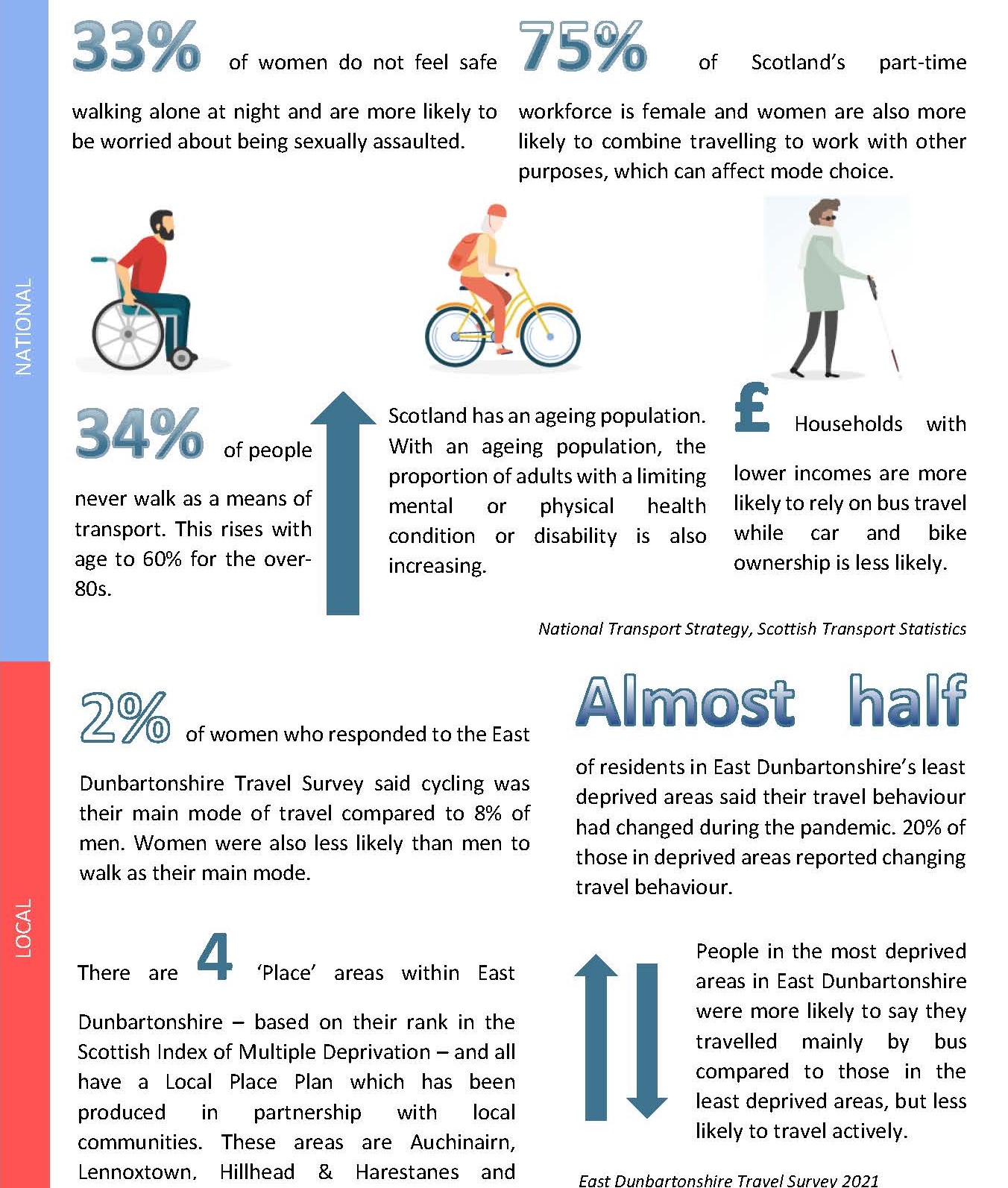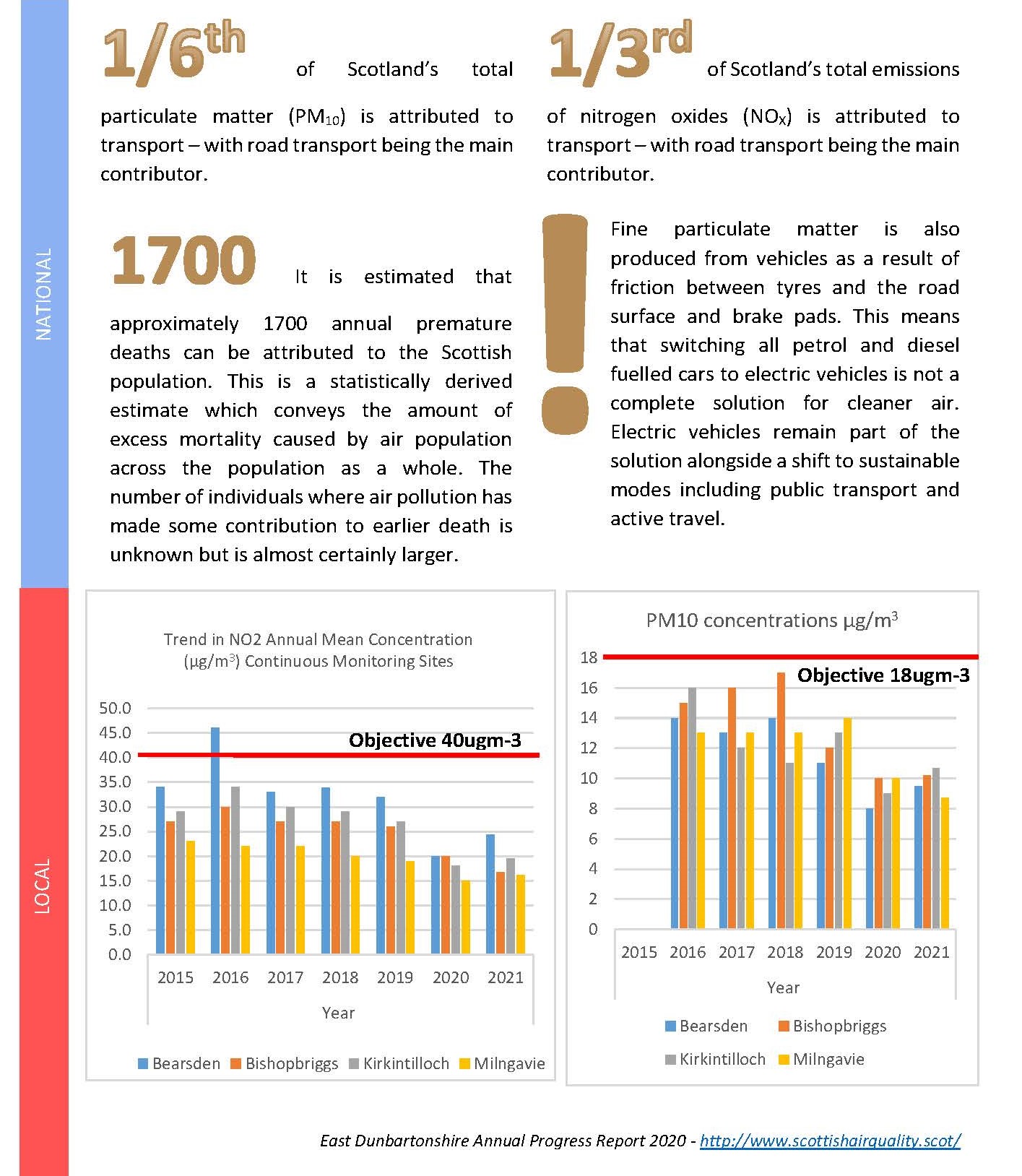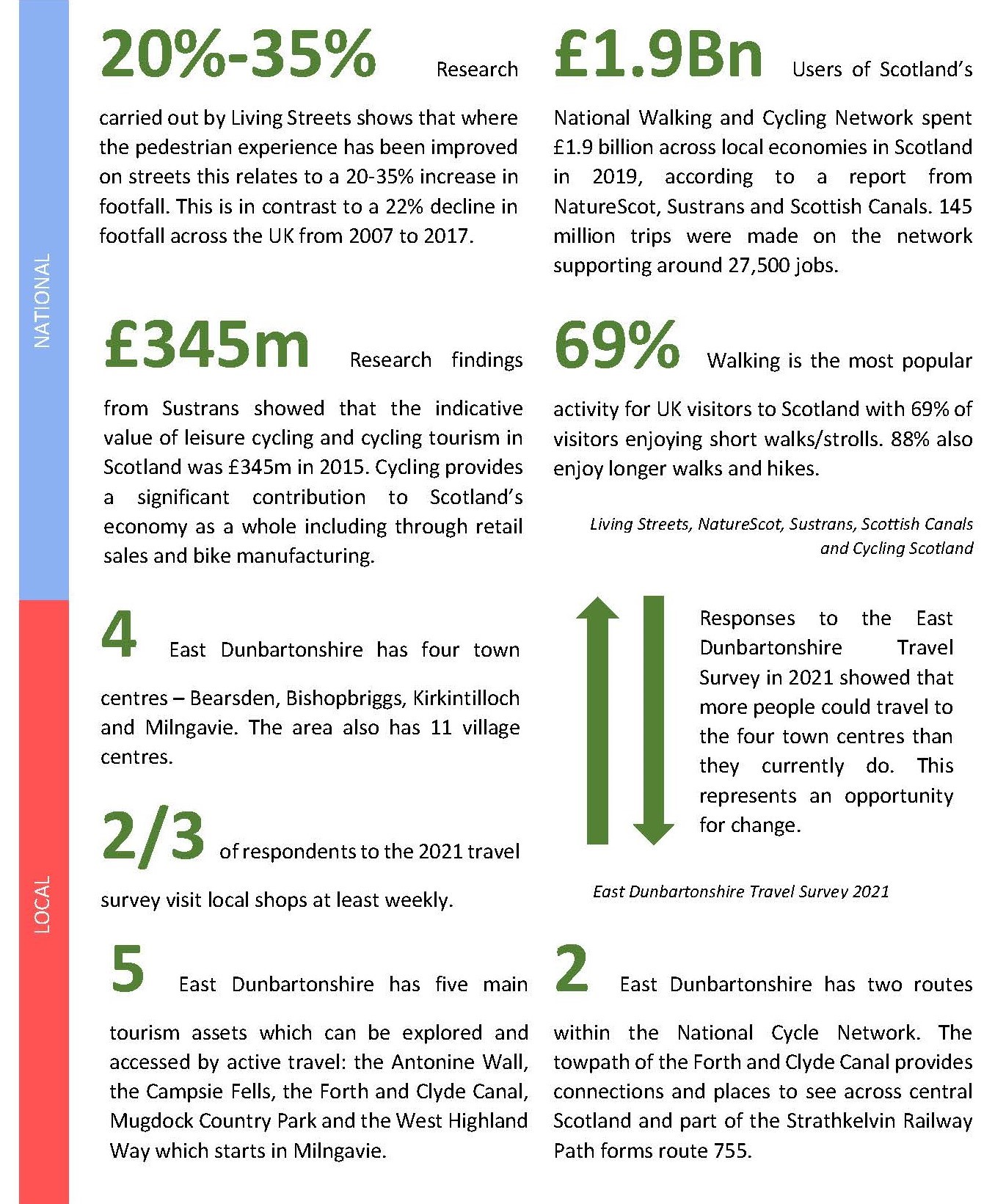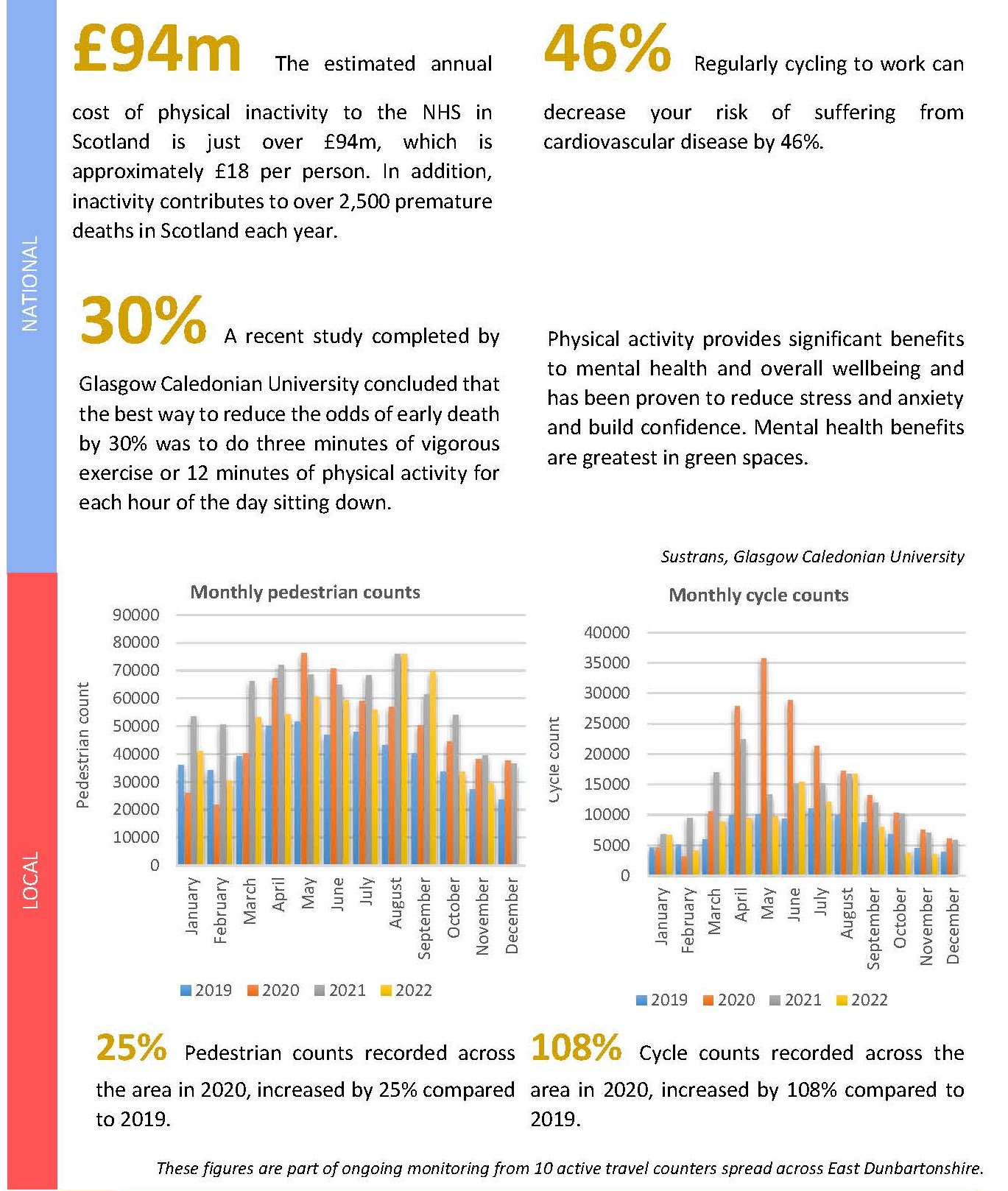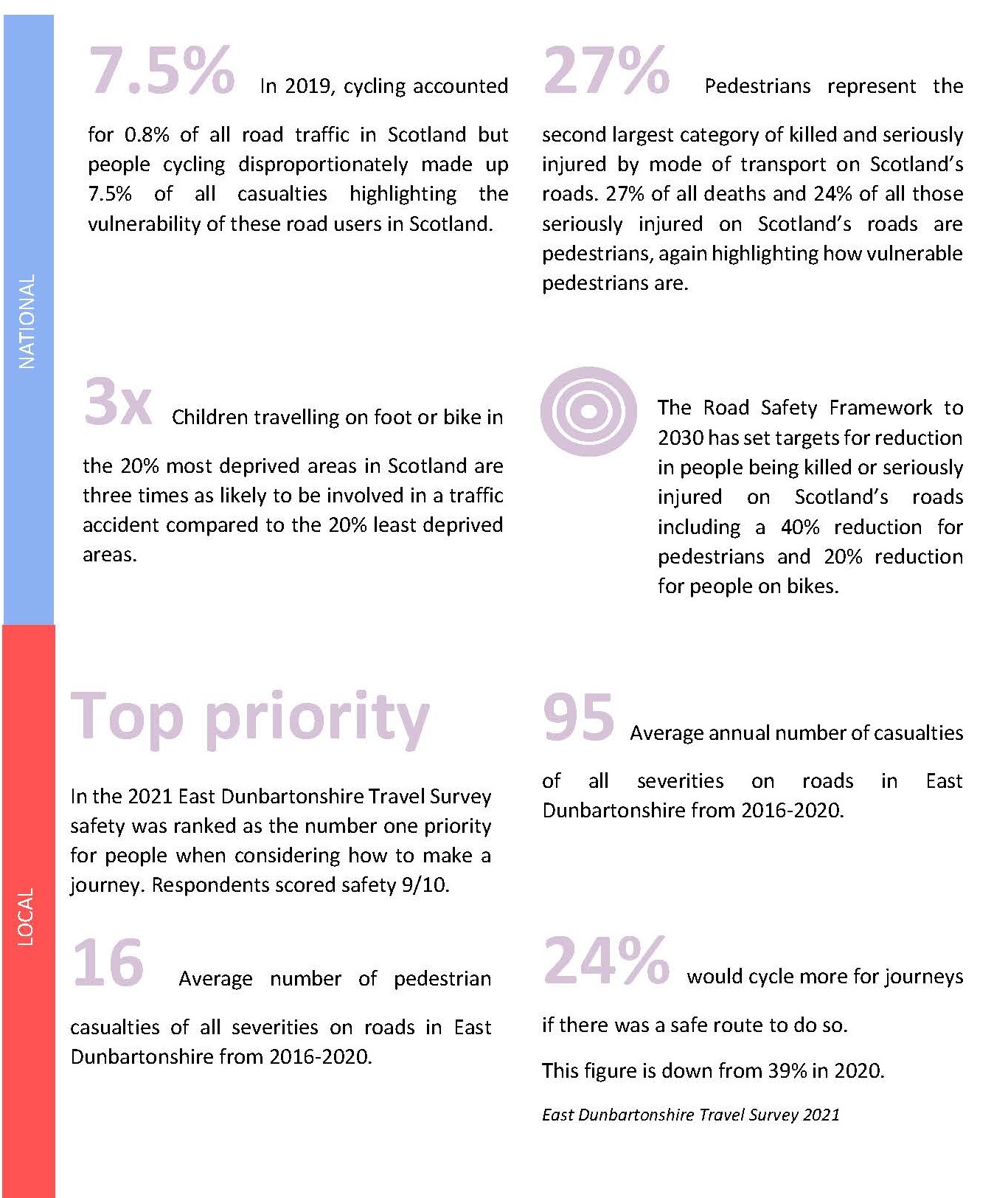The Local Transport Strategy 2020-2025 was approved in March 2020 and was informed by an extensive background report which included reviews of key national, regional and local policy as well as statistics and information on the East Dunbartonshire travel network. This evidence base informed the development of six Transport Planning Objectives to set a clear direction for the strategy to work towards.
Within this chapter, the key points of the LTS evidence base related to active travel are summarised for each objective, as well as policy changes and additional data recorded since March 2020. This includes a number of recent national policy publications and significant travel behaviour changes observed as a result of the COVID-19 pandemic.
On this page you will find information on:
- Increase modal shift towards more sustainable modes of travel for both travel to work/study and leisure trips
- Reduce inequality by providing high quality access for all
- Reduce emissions through reduced vehicle mileage in East Dunbartonshire
- Facilitate sustainable economic growth by improving connections across our boundaries and between our communities
- Improve health by increasing walking and cycling rates
- Improve safety on all modes of transport.
Increase modal shift towards more sustainable modes of travel for both travel to work/study and leisure trips
 Scotland’s second National Transport Strategy includes a Sustainable Travel Hierarchy, which puts walking, wheeling and cycling at the top as sustainable ways to travel. ‘Takes Climate Action’ is one of the priorities for the National Transport Strategy, reflecting the 2045 net zero target in the Climate Change (Emissions Reduction Targets) (Scotland) Act 2019. Replacing car journeys with those made by active travel is linked to achieving this which is why a strategic objective of the national Active Travel Framework is to ‘cut carbon emissions and other pollution’. The Scottish Government and COSLA have recently published a Route Map to achieve a 20% reduction in car km by 2030. The Strategic Transport Projects Review 2 sets out transport investment for the next 20 years and includes connected neighbourhood, segregated active freeways and connected towns. The numerous benefits for society, the climate and the individual of making more journeys by walking are included within the National Walking Strategy. The Cycling Framework and Delivery Plan for Active Travel in Scotland 2022-2030 requires active travel strategies to prioritise investment in the creation of a dense, coherent network of connected cycling infrastructure in every town and city that is segregated from traffic and integrated with public transport.
Scotland’s second National Transport Strategy includes a Sustainable Travel Hierarchy, which puts walking, wheeling and cycling at the top as sustainable ways to travel. ‘Takes Climate Action’ is one of the priorities for the National Transport Strategy, reflecting the 2045 net zero target in the Climate Change (Emissions Reduction Targets) (Scotland) Act 2019. Replacing car journeys with those made by active travel is linked to achieving this which is why a strategic objective of the national Active Travel Framework is to ‘cut carbon emissions and other pollution’. The Scottish Government and COSLA have recently published a Route Map to achieve a 20% reduction in car km by 2030. The Strategic Transport Projects Review 2 sets out transport investment for the next 20 years and includes connected neighbourhood, segregated active freeways and connected towns. The numerous benefits for society, the climate and the individual of making more journeys by walking are included within the National Walking Strategy. The Cycling Framework and Delivery Plan for Active Travel in Scotland 2022-2030 requires active travel strategies to prioritise investment in the creation of a dense, coherent network of connected cycling infrastructure in every town and city that is segregated from traffic and integrated with public transport.
 SPT is preparing a new Regional Transport Strategy and the Case for Change includes transport emissions as a key issue mainly due to the effects of road transport on the region’s emissions. The new RTS will commit SPT partners to a 20% reduction in car Km by 2030 and a target for 45% of trips in the region to be undertaken by modes other than the private car. The Glasgow Clyde Valley Green Network Partnership produced a Blueprint which is a framework for the creation of a strategic green network helping to deliver a connected and low-carbon place, in part, through a strategic access network.
SPT is preparing a new Regional Transport Strategy and the Case for Change includes transport emissions as a key issue mainly due to the effects of road transport on the region’s emissions. The new RTS will commit SPT partners to a 20% reduction in car Km by 2030 and a target for 45% of trips in the region to be undertaken by modes other than the private car. The Glasgow Clyde Valley Green Network Partnership produced a Blueprint which is a framework for the creation of a strategic green network helping to deliver a connected and low-carbon place, in part, through a strategic access network.
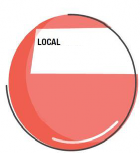 East Dunbartonshire’s Local Development Plan 2 includes policies intended to tackle climate change and support active travel throughout, including Policy 11 – Transport, which requires new development to be located in sustainable locations and align with the sustainable travel hierarchy by prioritising walking and cycling first. The Economic Recovery Plan (March 2021) identifies the impacts and key issues for East Dunbartonshire’s economy within the context of economic recovery from the COVID-19 pandemic and sets out actions the Council and Community Planning partners are delivering in response; the environment is identified as a priority area, under which there are actions to support more active travel and sustainable access to local businesses, workplaces and services. Work is underway to prepare a Climate Action Plan and a series of Climate Conversations were held in 2021 with active travel aspirations a key part of this work due to transport being the second largest source of emissions within East Dunbartonshire.
East Dunbartonshire’s Local Development Plan 2 includes policies intended to tackle climate change and support active travel throughout, including Policy 11 – Transport, which requires new development to be located in sustainable locations and align with the sustainable travel hierarchy by prioritising walking and cycling first. The Economic Recovery Plan (March 2021) identifies the impacts and key issues for East Dunbartonshire’s economy within the context of economic recovery from the COVID-19 pandemic and sets out actions the Council and Community Planning partners are delivering in response; the environment is identified as a priority area, under which there are actions to support more active travel and sustainable access to local businesses, workplaces and services. Work is underway to prepare a Climate Action Plan and a series of Climate Conversations were held in 2021 with active travel aspirations a key part of this work due to transport being the second largest source of emissions within East Dunbartonshire.
Priorities for Active Travel
- Provide safe and easy access to everyday places
- Improve integration between active travel and public transport
Reduce inequality by providing high quality access for all
 ‘Reduces inequalities’ is one of the priorities of Scotland’s second National Transport Strategy. This focuses on providing fair access to services and having a transport system that is easy to use and affordable for all. This section of NTS2 includes evidence and policies on poverty, gender, age and disability. Transport poverty can contribute to social isolation due to reduced travel opportunities. Women are less likely to report feeling safe walking alone at night compared to men and there are specific challenges for travel, including active travel for an ageing population and those people with disabilities. In recognition of these challenges for different groups, reducing inequalities has also been included in the outcomes of the national Active Travel Framework. Enabling easy, convenient safe independent mobility for everyone is also an aim of the National Walking Strategy, while Scotland’s Accessible Travel Framework aims to support disabled people’s access to travel so that everyone in Scotland has the same opportunities.
‘Reduces inequalities’ is one of the priorities of Scotland’s second National Transport Strategy. This focuses on providing fair access to services and having a transport system that is easy to use and affordable for all. This section of NTS2 includes evidence and policies on poverty, gender, age and disability. Transport poverty can contribute to social isolation due to reduced travel opportunities. Women are less likely to report feeling safe walking alone at night compared to men and there are specific challenges for travel, including active travel for an ageing population and those people with disabilities. In recognition of these challenges for different groups, reducing inequalities has also been included in the outcomes of the national Active Travel Framework. Enabling easy, convenient safe independent mobility for everyone is also an aim of the National Walking Strategy, while Scotland’s Accessible Travel Framework aims to support disabled people’s access to travel so that everyone in Scotland has the same opportunities.
‘ Accessing and using transport’ is a policy theme in SPT’s new Regional Transport Strategy. The key issue summarises challenges for different groups in the region including the cost of public transport and car ownership, the accessibility and the safety and security of using the transport network, including by active travel. Issues included a cluttered and poorly maintained physical environment for walking and wheeling as well as concerns for the safety of pedestrians and cyclists especially children, older people and those who are visually impaired or who have reduced personal mobility.
Accessing and using transport’ is a policy theme in SPT’s new Regional Transport Strategy. The key issue summarises challenges for different groups in the region including the cost of public transport and car ownership, the accessibility and the safety and security of using the transport network, including by active travel. Issues included a cluttered and poorly maintained physical environment for walking and wheeling as well as concerns for the safety of pedestrians and cyclists especially children, older people and those who are visually impaired or who have reduced personal mobility.
 Local Outcomes Improvement Plan includes outcomes for improving the quality of life for all within the area while also focusing on specific groups of people. The LOIP also sets out the Council’s approach to Place Planning and is supported by Locality (Place) Plan’s for areas highlighted within the Scottish Index of Multiple Deprivation. The Locality (Place) Plans highlight key access challenges including active travel for East Dunbartonshire’s most deprived areas and include some actions designed in partnership with the local community to increase opportunities to travel by walking, cycling or wheeling. The Local Development Plan 2 has inclusive design of new developments embedded within Policy 10 – Design and Placemaking, and Town Centre Strategies include actions and policies designed to create town centres that are accessible and considerate of the needs of all users. Helping reduce inequalities by providing diverse opportunities in open space and green networks for physical exercise, sport and recreation is also an objective within the Council’s existing Open Space Strategy.
Local Outcomes Improvement Plan includes outcomes for improving the quality of life for all within the area while also focusing on specific groups of people. The LOIP also sets out the Council’s approach to Place Planning and is supported by Locality (Place) Plan’s for areas highlighted within the Scottish Index of Multiple Deprivation. The Locality (Place) Plans highlight key access challenges including active travel for East Dunbartonshire’s most deprived areas and include some actions designed in partnership with the local community to increase opportunities to travel by walking, cycling or wheeling. The Local Development Plan 2 has inclusive design of new developments embedded within Policy 10 – Design and Placemaking, and Town Centre Strategies include actions and policies designed to create town centres that are accessible and considerate of the needs of all users. Helping reduce inequalities by providing diverse opportunities in open space and green networks for physical exercise, sport and recreation is also an objective within the Council’s existing Open Space Strategy.
Priorities for Active Travel
3. Empower and encourage all groups of people to walk, cycle and wheel more
Reduce emissions through reduced vehicle mileage in East Dunbartonshire
 The second National Transport Strategy describes road transport as the main source of emissions that contribute to poor air quality including small particulate matter (PM10) and Nitrogen Oxide gases (NOX). This also poses inequality issues as the vulnerable are disproportionately affected by poor air quality and air quality is often worse in more deprived areas of Scotland. The Scottish Government recently published a Route Map for reducing car kilometres by 20% by 2030. The Active Travel Framework highlights the benefits further participation in active travel can have on improving local air quality. The Cleaner Air for Scotland 2 builds on the active travel aims of the aforementioned strategies, the Cycling Framework and Delivery Plan and the National Walking Strategy. The strategy highlights the importance of active travel in improving local air quality and includes actions for delivery partners to work together to replace car journeys with those made by sustainable forms of transport.
The second National Transport Strategy describes road transport as the main source of emissions that contribute to poor air quality including small particulate matter (PM10) and Nitrogen Oxide gases (NOX). This also poses inequality issues as the vulnerable are disproportionately affected by poor air quality and air quality is often worse in more deprived areas of Scotland. The Scottish Government recently published a Route Map for reducing car kilometres by 20% by 2030. The Active Travel Framework highlights the benefits further participation in active travel can have on improving local air quality. The Cleaner Air for Scotland 2 builds on the active travel aims of the aforementioned strategies, the Cycling Framework and Delivery Plan and the National Walking Strategy. The strategy highlights the importance of active travel in improving local air quality and includes actions for delivery partners to work together to replace car journeys with those made by sustainable forms of transport.
 The Regional Transport Strategy has ‘to reduce carbon emissions and other harmful pollutants’ as one of its objectives, supported by policy themes and aims for modal shift to active travel and public transport. The Regional Transport Strategy outlines the issues the region has with poor air quality and the harmful effects this can have on health. The Case for Change refers to these emissions as preventable as road transport continues to be the main source. There are 15 Air Quality Management Areas in the Strathclyde region which have been designated due to recorded issues with PM10 and NOX emissions.
The Regional Transport Strategy has ‘to reduce carbon emissions and other harmful pollutants’ as one of its objectives, supported by policy themes and aims for modal shift to active travel and public transport. The Regional Transport Strategy outlines the issues the region has with poor air quality and the harmful effects this can have on health. The Case for Change refers to these emissions as preventable as road transport continues to be the main source. There are 15 Air Quality Management Areas in the Strathclyde region which have been designated due to recorded issues with PM10 and NOX emissions.
 The transport policy (Policy 11) in the Local Development Plan 2 for East Dunbartonshire includes requirements that development should be directed to locations where the need to travel is reduced and where the effect on air quality is minimised. To help achieve this, requirements of how new development should link into active travel and public transport networks are set out in each community policy. Road transport is a major contributor of PM10 and NOX emissions within East Dunbartonshire, especially within the Bishopbriggs Air Quality Management Areas (AQMA). The emissions within the AQMAs as well as other areas across the authority are monitored on an ongoing basis by the Council and set out within the Annual Progress Report. The Annual Progress Report also sets out the latest Council position on progress in delivering the Air Quality Action Plan for each AQMA. These actions are mainly related to reducing emissions from road transport including encouraging more journeys to be made by active travel in each area. The Council’s Town Centre Strategies also include objectives and actions aimed at improving local air quality through better placemaking and connectivity for active travel within town centres. Providing consolidated opportunities for active travel and improving air quality is also within the objectives of the local Core Path Plan.
The transport policy (Policy 11) in the Local Development Plan 2 for East Dunbartonshire includes requirements that development should be directed to locations where the need to travel is reduced and where the effect on air quality is minimised. To help achieve this, requirements of how new development should link into active travel and public transport networks are set out in each community policy. Road transport is a major contributor of PM10 and NOX emissions within East Dunbartonshire, especially within the Bishopbriggs Air Quality Management Areas (AQMA). The emissions within the AQMAs as well as other areas across the authority are monitored on an ongoing basis by the Council and set out within the Annual Progress Report. The Annual Progress Report also sets out the latest Council position on progress in delivering the Air Quality Action Plan for each AQMA. These actions are mainly related to reducing emissions from road transport including encouraging more journeys to be made by active travel in each area. The Council’s Town Centre Strategies also include objectives and actions aimed at improving local air quality through better placemaking and connectivity for active travel within town centres. Providing consolidated opportunities for active travel and improving air quality is also within the objectives of the local Core Path Plan.
Priorities for Active Travel
4. Improve active travel to and through Air Quality Management Areas
Facilitate sustainable economic growth by improving connections across our boundaries and between our communities
 ‘Helps deliver inclusive economic growth’ is one of the four priorities of the second National Transport Strategy. This includes mobility through an integrated network as well as providing tourism boosts through local assets. Supporting sustainable economic growth is an objective within the Active Travel Framework, ensuring that places are designed for active travel helps create attractive places, attracts investment and supports local economies. The benefits of active travel for local economies are raised in the Cycling Framework and Delivery Plan and the National Walking Strategy. In particular, the walking strategy highlights how an improved walking environment can provide access to jobs, facilities and onward journeys by public transport. It also boosts the local economy as people accessing local shops by walking often spend more money while they are there. Long- distance active networks are designated in the National Planning Framework 4 as a national development. These networks will enable access by sustainable transport to settlements, services, employment and transport
‘Helps deliver inclusive economic growth’ is one of the four priorities of the second National Transport Strategy. This includes mobility through an integrated network as well as providing tourism boosts through local assets. Supporting sustainable economic growth is an objective within the Active Travel Framework, ensuring that places are designed for active travel helps create attractive places, attracts investment and supports local economies. The benefits of active travel for local economies are raised in the Cycling Framework and Delivery Plan and the National Walking Strategy. In particular, the walking strategy highlights how an improved walking environment can provide access to jobs, facilities and onward journeys by public transport. It also boosts the local economy as people accessing local shops by walking often spend more money while they are there. Long- distance active networks are designated in the National Planning Framework 4 as a national development. These networks will enable access by sustainable transport to settlements, services, employment and transport
‘ Inclusive economic growth’ has been identified as a priority for the second Regional Transport Strategy. This will focus on delivering a transport network that supports the regional economy and provide better opportunities and fairer outcomes for all. The importance of tourism to the regional economy is also listed within the Case for Change. The Regional Economic Strategy (updated December 2021) is focused on economic inclusivity, productivity and also climate resilience. ‘Place is identified as one of the transformational opportunities in the Strategy, including improvements to all types of infrastructure to ensure residents have access to economic opportunities. The Glasgow Clyde Valley Green Network Partnership’s Blueprint will also contribute to sustainable inclusive economic growth.
Inclusive economic growth’ has been identified as a priority for the second Regional Transport Strategy. This will focus on delivering a transport network that supports the regional economy and provide better opportunities and fairer outcomes for all. The importance of tourism to the regional economy is also listed within the Case for Change. The Regional Economic Strategy (updated December 2021) is focused on economic inclusivity, productivity and also climate resilience. ‘Place is identified as one of the transformational opportunities in the Strategy, including improvements to all types of infrastructure to ensure residents have access to economic opportunities. The Glasgow Clyde Valley Green Network Partnership’s Blueprint will also contribute to sustainable inclusive economic growth.
 The first outcome of the Local Outcomes Improvement Plan is for East Dunbartonshire to have a sustainable and resilient economy with busy town and village centres, a growing business base and to be an attractive place in which to visit and invest. To build on this outcome the Economic Development Strategy includes objectives on increasing tourism and sustainable development. This includes attracting pedestrians and cyclists into town centres by ensuring high-quality routes to surrounding areas nearby and promoting behaviour change initiatives for active travel to reduce reliance on cars and therefore reduce carbon emissions. The Economic Development Strategy also includes actions on attracting visitors to the area’s tourism assets by walking and cycling. The Local Development Plan 2 includes active travel elements within various tourism and economic development-related policies including 14 and 16. The Core Path Plan aims to deliver a network that can deliver growth in walking and cycling in the area supporting local businesses by attracting visitors. Town Centre Strategies for this area also include objectives and actions to encourage visitors and footfall for local businesses including making it easier to navigate spaces by walking and cycling.
The first outcome of the Local Outcomes Improvement Plan is for East Dunbartonshire to have a sustainable and resilient economy with busy town and village centres, a growing business base and to be an attractive place in which to visit and invest. To build on this outcome the Economic Development Strategy includes objectives on increasing tourism and sustainable development. This includes attracting pedestrians and cyclists into town centres by ensuring high-quality routes to surrounding areas nearby and promoting behaviour change initiatives for active travel to reduce reliance on cars and therefore reduce carbon emissions. The Economic Development Strategy also includes actions on attracting visitors to the area’s tourism assets by walking and cycling. The Local Development Plan 2 includes active travel elements within various tourism and economic development-related policies including 14 and 16. The Core Path Plan aims to deliver a network that can deliver growth in walking and cycling in the area supporting local businesses by attracting visitors. Town Centre Strategies for this area also include objectives and actions to encourage visitors and footfall for local businesses including making it easier to navigate spaces by walking and cycling.
Priorities for Active Travel
5. Make East Dunbartonshire an attractive place for active travel to generate more sustainable business for the local economy
Improve health by increasing walking and cycling rates
 The second National Transport Strategy has a priority to have a transport system that ‘improves our health and wellbeing’. This includes enabling people to make healthy travel choices and ensuring active travel will be the preferred mode of travel having a significant effect on individual health and wellbeing. The Active Travel Framework includes an objective for better health and safer travel for all by making active travel easier for everyone. The Cycling Framework and Delivery Plan and the National Walking Strategy also recognise the benefits increased walking and cycling can have for personal health and overall wellbeing. The National Planning Framework 4 identifies increases in active travel levels as an opportunity to improve the health and wellbeing of people living in Scotland. In addition, the Active Scotland Delivery Plan, which has a vision of people in Scotland being more active, more often, includes outcomes on reducing levels of inactivity and supporting wellbeing and community resilience through physical activity.
The second National Transport Strategy has a priority to have a transport system that ‘improves our health and wellbeing’. This includes enabling people to make healthy travel choices and ensuring active travel will be the preferred mode of travel having a significant effect on individual health and wellbeing. The Active Travel Framework includes an objective for better health and safer travel for all by making active travel easier for everyone. The Cycling Framework and Delivery Plan and the National Walking Strategy also recognise the benefits increased walking and cycling can have for personal health and overall wellbeing. The National Planning Framework 4 identifies increases in active travel levels as an opportunity to improve the health and wellbeing of people living in Scotland. In addition, the Active Scotland Delivery Plan, which has a vision of people in Scotland being more active, more often, includes outcomes on reducing levels of inactivity and supporting wellbeing and community resilience through physical activity.
 An ‘improved quality of life’ is one of the priorities in the new Regional Transport Strategy. This is to ensure the transport system can help everyone achieve better health and wellbeing, leading active and fulfilling lives. Regional levels of active travel are lower compared to other areas of Scotland and active living has been identified as a key issue within the strategy which sets out policies tackling existing barriers people experience across the region. Clydeplan, the region’s strategic development plan includes a policy for the City Region to be a connected place and within this, highlights the importance of active travel in improving health across the region. The Glasgow Clyde Valley Green Network Partnership’s Blueprint aims to help people across the region access the green network to help them live healthy lives and boost mental wellbeing.
An ‘improved quality of life’ is one of the priorities in the new Regional Transport Strategy. This is to ensure the transport system can help everyone achieve better health and wellbeing, leading active and fulfilling lives. Regional levels of active travel are lower compared to other areas of Scotland and active living has been identified as a key issue within the strategy which sets out policies tackling existing barriers people experience across the region. Clydeplan, the region’s strategic development plan includes a policy for the City Region to be a connected place and within this, highlights the importance of active travel in improving health across the region. The Glasgow Clyde Valley Green Network Partnership’s Blueprint aims to help people across the region access the green network to help them live healthy lives and boost mental wellbeing.
 The Local Outcomes Improvement Plan includes outcomes for children and young people to be safe, healthy and ready to learn as well as for everyone to experience good physical health and mental wellbeing. The Local Development Plan 2 includes policies for new development to be designed to a high standard to prioritise active travel and lead to healthy, active and inclusive lifestyles. The Open Space Strategy and Green Network Strategy both aim to improve access and provision for walking and cycling to deliver enhanced health and wellbeing. By providing a network that can give everyone opportunities for uncomplicated exercise, the Core Path Plan aims to improve the health and wellbeing of people in the area. The Culture, Leisure and Sport Strategy aims to improve health and wellbeing by providing opportunities for everyone to lead full and active lives. Air Quality Action Plans and Locality (Place) Plans also include various actions to deliver further opportunities for local active travel and improve the health and wellbeing of all residents.
The Local Outcomes Improvement Plan includes outcomes for children and young people to be safe, healthy and ready to learn as well as for everyone to experience good physical health and mental wellbeing. The Local Development Plan 2 includes policies for new development to be designed to a high standard to prioritise active travel and lead to healthy, active and inclusive lifestyles. The Open Space Strategy and Green Network Strategy both aim to improve access and provision for walking and cycling to deliver enhanced health and wellbeing. By providing a network that can give everyone opportunities for uncomplicated exercise, the Core Path Plan aims to improve the health and wellbeing of people in the area. The Culture, Leisure and Sport Strategy aims to improve health and wellbeing by providing opportunities for everyone to lead full and active lives. Air Quality Action Plans and Locality (Place) Plans also include various actions to deliver further opportunities for local active travel and improve the health and wellbeing of all residents.
Priorities for Active Travel
6. Improve physical health, mental health and overall wellbeing by providing better opportunities for walking, cycling and wheeling for leisure and exercise purposes, including enhanced access to areas of greenspace
Improve safety on all modes of transport.
 The second National Transport Strategy states that the transport system in Scotland needs to be safe and secure to enable a healthy, active and fit nation. The importance of having safer travel for all to ensure active travel is easier for everyone is highlighted within the objectives of the Active Travel Framework. Active and sustainable travel is one of twelve themes within Scotland’s Road Safety Framework to 2030. The Framework recognises the vulnerability of pedestrians and people on bikes on Scotland’s roads and notes that further work is required to improve safety levels, both perceived and real, to ensure active travel investment can translate to increased levels of everyday walking and cycling. This framework sets out the ambition for zero casualties on Scottish roads by 2050. As part of this framework, the Scottish Government recommends that all appropriate roads in built-up areas will have a 20mph speed limit by 2025. Scotland’s Accessible Travel Framework supports disabled people’s rights by aiming to improve access to travel. This includes outcomes to make sure disabled people make successful door-to-door journeys more often. Through developing the Framework, disabled people said it was important to ensure paths were clear, safe and
The second National Transport Strategy states that the transport system in Scotland needs to be safe and secure to enable a healthy, active and fit nation. The importance of having safer travel for all to ensure active travel is easier for everyone is highlighted within the objectives of the Active Travel Framework. Active and sustainable travel is one of twelve themes within Scotland’s Road Safety Framework to 2030. The Framework recognises the vulnerability of pedestrians and people on bikes on Scotland’s roads and notes that further work is required to improve safety levels, both perceived and real, to ensure active travel investment can translate to increased levels of everyday walking and cycling. This framework sets out the ambition for zero casualties on Scottish roads by 2050. As part of this framework, the Scottish Government recommends that all appropriate roads in built-up areas will have a 20mph speed limit by 2025. Scotland’s Accessible Travel Framework supports disabled people’s rights by aiming to improve access to travel. This includes outcomes to make sure disabled people make successful door-to-door journeys more often. Through developing the Framework, disabled people said it was important to ensure paths were clear, safe and  obstacle-free.
obstacle-free.
The new Regional Transport Strategy notes the challenges faced for safety and security for walking, wheeling and cycling in the region. Specific concerns were raised including traffic volumes, traffic speeds, accessibility of road crossings and general concerns for the safety of children, older people, visually impaired people and those with reduced mobility. The report also discusses personal safety and security concerns which are barriers to encouraging more active travel, especially for older women and disabled people.
 The fourth outcome within the Local Outcomes Improvement Plan is for East Dunbartonshire to be a safe place in which to live, work and visit. One of the objectives within the Development Strategy of the Proposed Local Development Plan 2 is to create places that are safe, easy to move around and well-connected by walking, cycling and public transport. The Culture, Leisure and Sport Strategy includes actions for improving the quality, safety and routing of paths and footways from residential areas to health and leisure centres. There are also a number of actions within the Town Centre Strategies and Locality (Place) Plans to improve the safety of active travel within local areas of East Dunbartonshire in response to concerns raised through consultation as part of the process of developing the plans.
The fourth outcome within the Local Outcomes Improvement Plan is for East Dunbartonshire to be a safe place in which to live, work and visit. One of the objectives within the Development Strategy of the Proposed Local Development Plan 2 is to create places that are safe, easy to move around and well-connected by walking, cycling and public transport. The Culture, Leisure and Sport Strategy includes actions for improving the quality, safety and routing of paths and footways from residential areas to health and leisure centres. There are also a number of actions within the Town Centre Strategies and Locality (Place) Plans to improve the safety of active travel within local areas of East Dunbartonshire in response to concerns raised through consultation as part of the process of developing the plans.
Priorities for Active Travel
7. Ensure vulnerable road users, including those walking, cycling and wheeling, are safer on East Dunbartonshire’s road network
8. Ensure surfaces are of a high standard so appropriate paths and routes can be safely accessed and enjoyed by all
